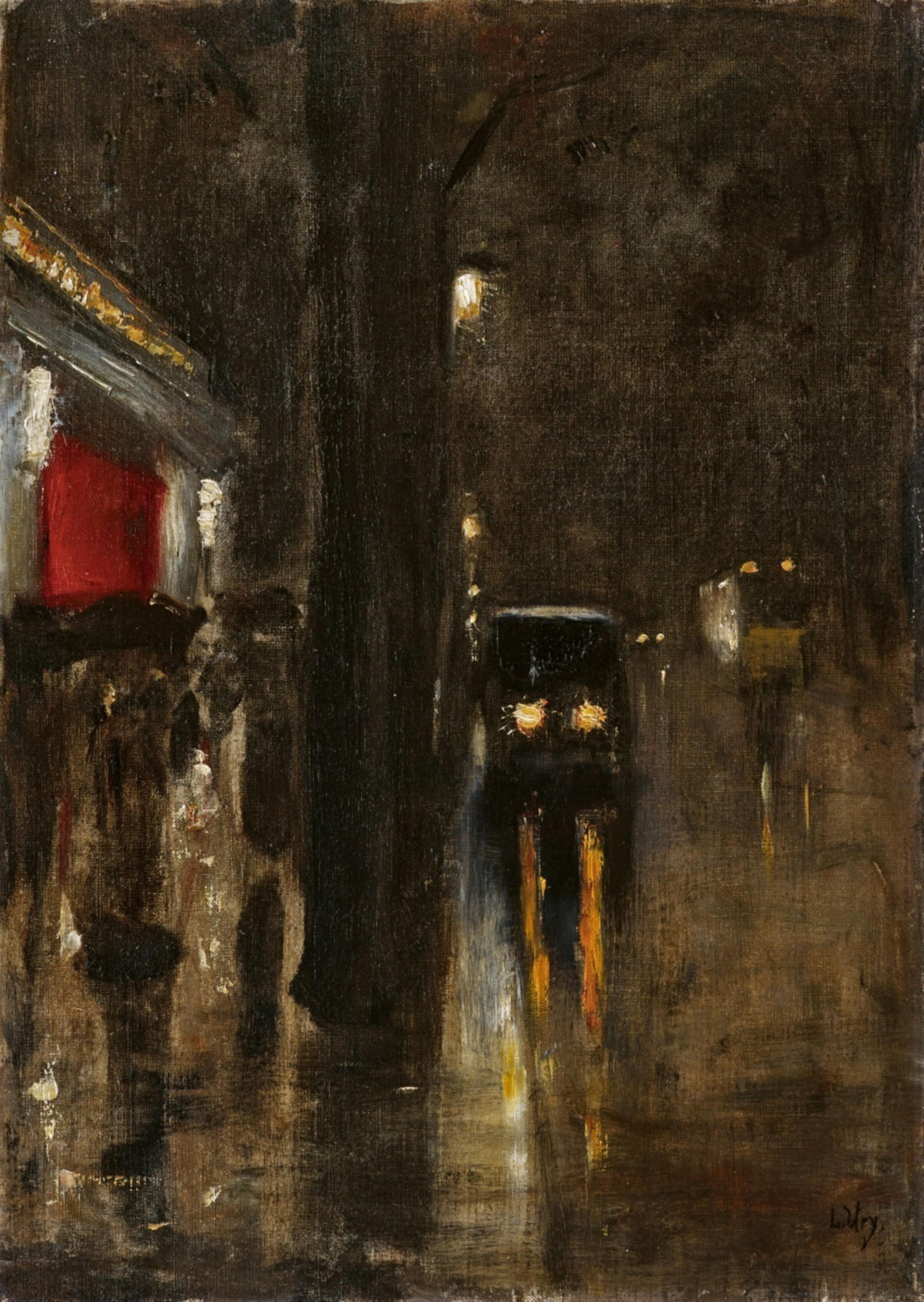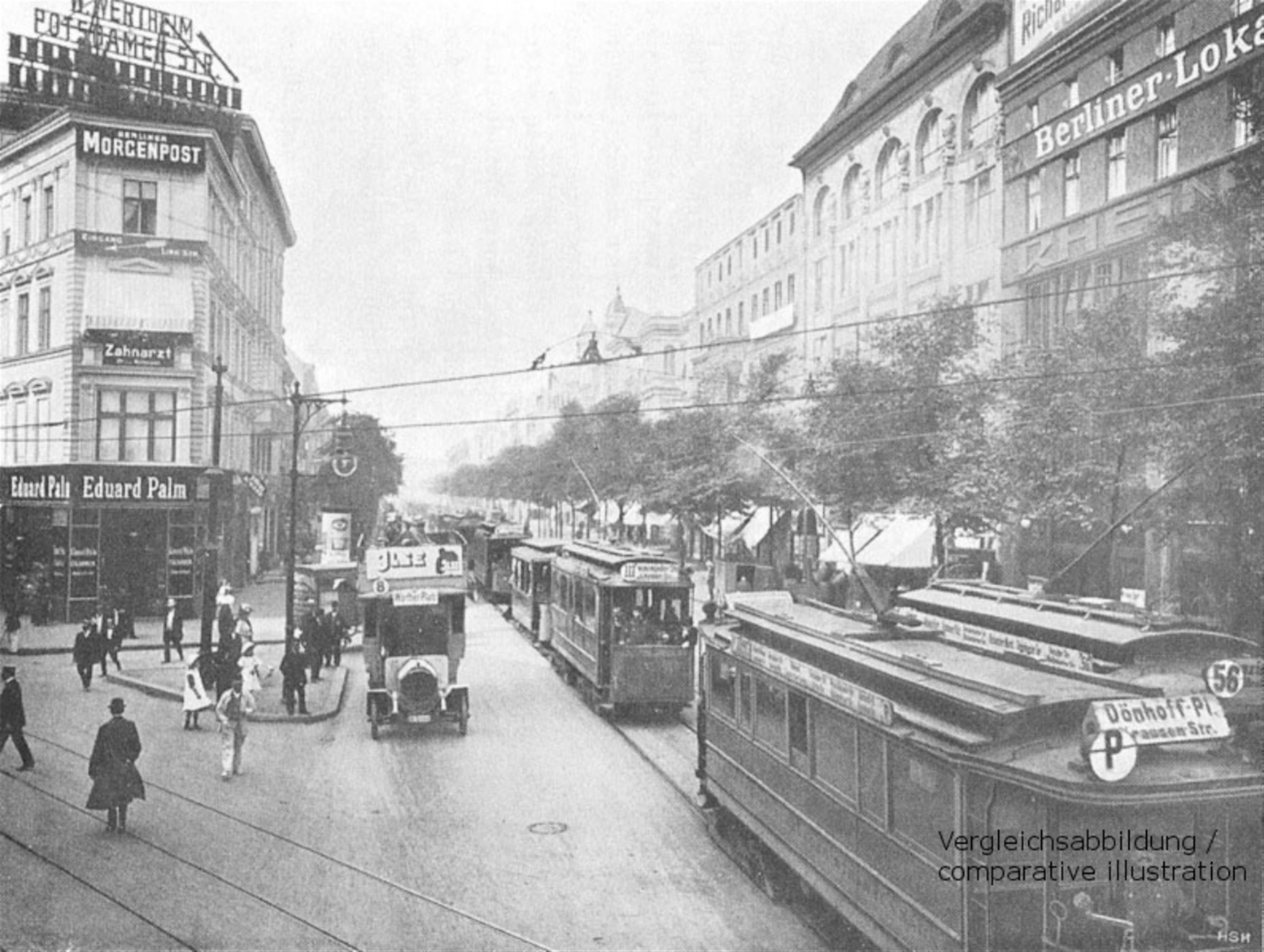Lesser Ury
Nächtliche Straßenszene, Berlin (In den Zelten)
Circa 1915/1920
Oil on canvas 51.3 x 36.5 cm Framed. Signed 'L. Ury' in black lower left. - Short canvas cuts directly at the corners of the stretcher.
Lesser Ury, the master of nocturnal urban scenes! It would be unfair to reduce the artist solely to his work in this genre. However - alongside the Impressionistic landscapes featuring the lakes outside Berlin, delightful portraits and coffee-house scenes - it is, after all, the street scenes in which Ury depicts the nocturnal activity of night owls and flâneurs along the boulevards: if possible, in the rain, among the reflecting backlight of the carriages and gas lanterns. This type of picture is what comes to mind when we hear or read his name, and they became the splendid and inimitable trademark of the artist, who was born in Birnbaum, near Poznan, in 1861.
After studying at the academy of art in Düsseldorf and a grand tour by way of Brussels, Antwerp and Paris, Ury settled in Berlin in 1887. It was not easy for him to assert himself against the dominant figures in Berlin: against Max Liebermann, for example, with whom he had a falling out after an initial friendship. On the other hand Adolf von Menzel, the chronicler of Berlin, admired and supported this quiet and personally reserved colleague following his first major show, which was held at the gallery of Fritz Gurlitt in 1893 and was reprimanded sharply by the critics. After Lovis Corinth succeeded Liebermann as president of the Secession in 1911, he also made efforts to help the urban chronicler. “In Berlin Ury changed from a Naturalist into an Impressionist by discovering the picturesque beauties of the night, when the lights flare up in the streets and coffee houses. The magical light took hold of him with irresistible force; in the pale yellowish glow of gas lanterns, people and vehicles emerge like shadows out of the darkness or the veil of pouring rain and, barely recognisable as individuals, they cast their reflections on the wet asphalt.” (Karl Schwarz, Lesser Ury: Ein Essay, in: Hermann A. Schlögl, Lesser Ury, Zauber des Lichts, exhib. cat. Käthe-Kollwitz-Museum, Berlin 1995, p. 78). Lesser Ury then preferred busy streets and prominent squares, such as Potsdamer Platz or next to Brandenburg Gate, and as an attentive observer he visited establishments known throughout the city, such as “In den Zelten”.
The title of the picture refers to a historical location, a no longer existing stretch of street in the parliamentary and government quarter of the Tiergarten district. Friedrich II had once approved the setting up of canvas tents where refreshments could be sold to those out for a stroll or on an excursion. Over the decades these tents, which were to be taken down for the winter, transformed into permanent buildings that made it possible to provide for flâneurs and pleasure seekers throughout the year. Ury has depicted a typical, rainy autumn scene with a pavilion at the edge of a broad pavement; a glittering string of lights above the cornice and a large, bright red poster on the façade are meant to increase interest in what it has to offer inside. Passers-by hurry along the tree-lined avenue, a motor cab stops and sheds light on the dark surface of the street, a small streetcar becomes lost in the darkness of the night.
Keeping his distance, Lesser Ury progressed to become a sophisticated voyeur of human behaviour. At the same time, his pictures document Berlin's development into a modern metropolis throughout the years until his death, in 1931, but they do so without emphasising social problems. The big city fascinated him as a picturesque motif dominated by movement, speed, light and darkness.
Comparative illustration: historic photography, Berlin Potsdamer Straße 1910
Certificate
With a photo-certificate from Sibylle Groß, Berlin, dated 12 June 2017. The painting will be included in the catalogue raisonné.
Provenance
Collection Jakob Gottschalk, Berlin; family possession, Brasil; Private collection, Israel; Private collection




